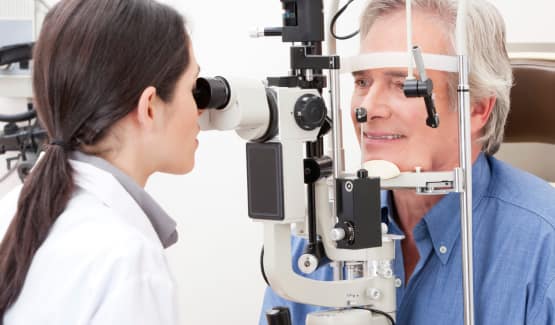Dry eye is the result of insufficient tears needed to lubricate the eye. Tears are essential for maintaining eye health and to provide clear vision. Dry eye is a result of the body’s inability to produce enough tears or stable tears. Our doctors are trained to diagnose and treat all types of dry eye. The treatment options include punctual plugs, steroid eye drops, Antibiotics, Restasis, and in office gland expression.
Dry eye is a common condition that occurs when your tears are not able to provide sufficient lubrication for the ocular surface. This can result from the eye not producing enough tears, producing poor quality tears or from increased tear evaporation.

The most common symptoms of dry eyes are blurry vision, tearing, burning sensation or the feeling that you have sand or grit in your eye. Other symptoms include eye redness, stringy mucus in the eye or around the eyes, sensitivity to light and difficulty wearing contact lenses. Symptoms can be fleeting but in some cases symptoms can persist for a long period of time.
The leading cause of evaporative dry eye is meibomian gland dysfunction. Meibomian glands are located behind our eyelashes in the upper and lower eyelids. These glands produce oil, known as the lipid layer of the tear film which is essential in preventing rapid evaporation of the tears. When these glands become backed up or inflamed, oil is not secreted sufficiently thereby it affects the quality and stability of the tear film leading to symptoms of dry eye.
Dry eyes can be exacerbated by the environment in which you live. People who live in dry or windy climates where there is less moisture in the air often have a greater risk of developing dry eye. The winter season is also the time of year in which dry eye is more likely to occur due to the dry air and the heating conditions in our homes and cars. Other environmental stressors include cigarette smoke and air pollution.
Activities such as reading, driving or working at the computer can decrease the blink rate by fifty percent resulting in dry eye.
Mal position of the eyelids, such as out-turning of the lids (ectropian) and in-turning of the lids (entropian) can also cause evaporative dry eye.

As we age our nerve stimulation for the production of tears decreases leading to decreased tear production. Women are more likely than men to develop dry eye due to hormonal fluctuations that occur with menopause, pregnancy or breastfeeding. Medical conditions that cause decreased tear production include diabetes, Sjogren’s syndrome, rheumatoid arthritis, lupus, scleroderma, thyroid disorders and vitamin A deficiency as well as other autoimmune conditions. Lastly, medications can decrease the production of tears leading to dry eye. These medications are antihistamines, decongestants, hormone replacement therapy, antidepressants and certain medications for high blood pressure, acne, birth control and Parkinson’s disease.
Complications of dry eye include eye infections, damage to the surface of your eyes and decreased quality of life.

For some people regular lubrication with over the counter eye drops such as artificial tears is enough to help with mild dry eye symptoms. For those symptoms that are persistent and more serious, treatments can be employed that focus on reversing or managing the condition that causes the dry eye. This can include stopping a medication known to cause dry eye or treating a condition, such as meibomian gland dysfunction, with warm compresses and/or ophthalmic antibiotic ointments. Restasis, another treatment for dry eye, is a prescription eye drop that is specifically designed to treat dry eye. It helps to treat dry eye by producing more qualitative tears and by reducing inflammation associated with dry eye. Another form of treatment is punctal occlusion. This can be done partially or completely and involves closing your tear ducts which serve as a drainage system for your tears. The tear ducts can be plugged with tiny silicone plugs that are removable. Punctal occlusion prevents tears from draining allowing more tears to coat the surface of the eye and thereby decreasing symptoms of dry eye. These treatments can be used alone or combined to help alleviate symptoms. Unfortunately, dry eye is a chronic condition that cannot be cured but can be effectively treated with different treatment options. See your eye doctor today to determine the best treatment for your eyes.

